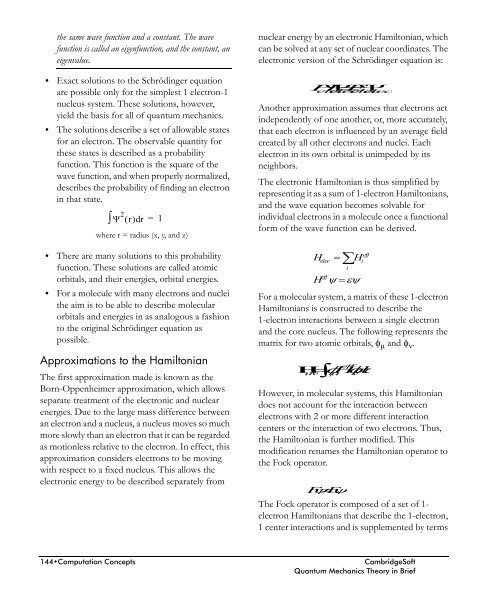Chem3D Users Manual - CambridgeSoft
Chem3D Users Manual - CambridgeSoft
Chem3D Users Manual - CambridgeSoft
Create successful ePaper yourself
Turn your PDF publications into a flip-book with our unique Google optimized e-Paper software.
the same wave function and a constant. The wave<br />
function is called an eigenfunction, and the constant, an<br />
eigenvalue.<br />
nuclear energy by an electronic Hamiltonian, which<br />
can be solved at any set of nuclear coordinates. The<br />
electronic version of the Schrödinger equation is:<br />
Administrator<br />
• Exact solutions to the Schrödinger equation<br />
are possible only for the simplest 1 electron-1<br />
nucleus system. These solutions, however,<br />
yield the basis for all of quantum mechanics.<br />
• The solutions describe a set of allowable states<br />
for an electron. The observable quantity for<br />
these states is described as a probability<br />
function. This function is the square of the<br />
wave function, and when properly normalized,<br />
describes the probability of finding an electron<br />
in that state.<br />
∫Ψ 2 ()r r d = 1<br />
where r = radius (x, y, and z)<br />
H elec<br />
Ψ elec<br />
=E elec<br />
Ψ elec<br />
Another approximation assumes that electrons act<br />
independently of one another, or, more accurately,<br />
that each electron is influenced by an average field<br />
created by all other electrons and nuclei. Each<br />
electron in its own orbital is unimpeded by its<br />
neighbors.<br />
The electronic Hamiltonian is thus simplified by<br />
representing it as a sum of 1-electron Hamiltonians,<br />
and the wave equation becomes solvable for<br />
individual electrons in a molecule once a functional<br />
form of the wave function can be derived.<br />
• There are many solutions to this probability<br />
function. These solutions are called atomic<br />
orbitals, and their energies, orbital energies.<br />
• For a molecule with many electrons and nuclei<br />
the aim is to be able to describe molecular<br />
orbitals and energies in as analogous a fashion<br />
to the original Schrödinger equation as<br />
possible.<br />
Approximations to the Hamiltonian<br />
The first approximation made is known as the<br />
Born-Oppenheimer approximation, which allows<br />
separate treatment of the electronic and nuclear<br />
energies. Due to the large mass difference between<br />
an electron and a nucleus, a nucleus moves so much<br />
more slowly than an electron that it can be regarded<br />
as motionless relative to the electron. In effect, this<br />
approximation considers electrons to be moving<br />
with respect to a fixed nucleus. This allows the<br />
electronic energy to be described separately from<br />
H elec<br />
=<br />
∑<br />
H eff ψ =εψ<br />
H i<br />
eff<br />
For a molecular system, a matrix of these 1-electron<br />
Hamiltonians is constructed to describe the<br />
1-electron interactions between a single electron<br />
and the core nucleus. The following represents the<br />
matrix for two atomic orbitals, φ µ and φ ν .<br />
H uv ∫ =φ H eff µ v<br />
φdτ<br />
i<br />
However, in molecular systems, this Hamiltonian<br />
does not account for the interaction between<br />
electrons with 2 or more different interaction<br />
centers or the interaction of two electrons. Thus,<br />
the Hamiltonian is further modified. This<br />
modification renames the Hamiltonian operator to<br />
the Fock operator.<br />
Fψ=Eψ<br />
The Fock operator is composed of a set of 1-<br />
electron Hamiltonians that describe the 1-electron,<br />
1 center interactions and is supplemented by terms<br />
144•Computation Concepts<br />
<strong>CambridgeSoft</strong><br />
Quantum Mechanics Theory in Brief











